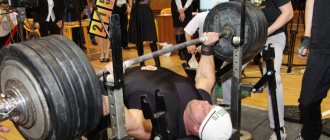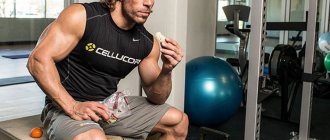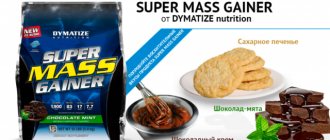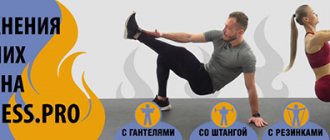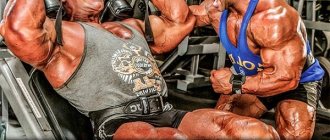Mass training program
In order to get big quickly, it's important to focus your efforts on what really works - that is, a basic training program. In turn, a basic mass program is any gym program that involves performing multi-joint strength exercises with maximum weights, a limited number of approaches and a fairly low number of repetitions (from 3 to 6).
The basic training program described below is a barbell lifting program designed to increase strength. If muscle strength increases, then along with proper nutrition, the volume of muscle fiber will begin to increase. In other words, following a basic program and following a hypercaloric diet for muscle growth will help you get pumped up and bulk up quickly.
If you consistently follow the tips below, you can build 5-7 kg of quality muscle in the first 6-8 weeks of following a basic training program. However, it is extremely important to follow the basic rules of the program and train for hypertrophy (that is, avoid isolation exercises completely), as well as pay special attention to your nutrition.
What is a basic training program?
The basic training program is a mass-gaining program based on working all major muscle groups in one short workout. It is recommended to use multi-joint basic exercises as exercises - it is believed that they have the greatest effect on increasing hormonal levels and increasing the production of testosterone in the body. Which ultimately helps build muscles.
This program involves three short (no more than 45-50 minutes) but intense workouts per week, as well as enhanced nutrition (at least 3500-4000 kcal per day). Remember that high-calorie nutrition is the most important component of muscle pumping and growth - without additional calories, the body will not physically be able to build muscle, even when taking expensive sports nutrition.
Basic exercise program
The basic training program was first described in a book by Bill Star, an Olympic weightlifting champion. In his experience, muscle hypertrophy is best achieved by compound exercises performed in 4-6 sets of 4-6 repetitions and increasing the load on each set (2). To keep it simple, he recommended 5 sets of 5 repetitions of each exercise, hence the alternate name for the program, “5x5.”
Training in the gym according to the basic program is carried out every three days, alternating in a staggered order: Monday - training A, Thursday - training B, Sunday - A, Wednesday - B, Saturday - A. If you want to train according to the more usual “Monday” pattern , Wednesday, Friday”, make sure that the time between workouts is at least 48-55 hours.
Why is there so little exercise?
The reason for using five strength exercises exclusively is that they teach the body's muscles to work together. The classic basic weight program is not recommended to replace squats with a barbell with leg presses in a machine or supplement the program with abdominal or biceps exercises. The reason is stated above - the program was developed for lifters training with barbells.
However, remember that first it is important to learn how to perform the exercises correctly - even the slightest technique errors can lead to injury. This is why beginners at the gym either need to train with a personal trainer, or stick to a simplified training program and average working weights. Start with a medium weight and 4-5 working sets of 8-10 repetitions, gradually working up to 3 sets of 4-6 repetitions.
The best basic exercises for gaining mass
Squats
This exercise is the basis of mass training, it uses the maximum number of muscles and joints, gives a powerful anabolic boost to the entire body, and promotes the rapid growth of all major muscle groups. Involved: gluteal muscles, quadriceps femoris, lumbar extensors, rectus abdominis. Secondarily, the thigh biceps and calf muscles are included.
- Place the barbell on your shoulders below your neck so that the bar rests on the top of your trapezius muscle.
- Bring your shoulder blades together and open your chest.
- Tighten your abdominal muscles to stabilize your spine.
- While inhaling, smoothly lower your pelvis and hips to a parallel line with the floor. The knees should not form sharp angles, the shin should remain in a vertical straight line. The lower back is not rounded; for this, the chin is raised and the gaze is directed to the ceiling. The body should not fall too low on the hips, and the center of gravity should be on the heels.
- With an exhalation, we straighten our torso, tensing our buttocks and thighs, not forgetting about the tension in our abdominal muscles, and straighten up completely.
Deadlift
This exercise, like squats, involves the maximum number of muscle groups - the quadriceps and biceps of the thigh, calves, lower back, and rectus abdominis. The trapezius, forearm, and lower leg also work
The peculiarities of the technique are that there is a strong load in the lumbar region, so the exercise visually expands the waist, which is why this type of deadlift is more suitable for men .
- Place the barbell on the floor, face the bar with your feet parallel, shoulder-width apart.
- Squat down with your knees bent at 90 degrees, straighten your back, slightly arching your lower back, tighten your abs.
- With your palms, clasp the bar across the width of your shoulder joints.
- As you exhale, lift the body, straightening your knees and torso, lift the barbell vertically along your shins with straight arms.
- It is important to rise with the whole body at the same time , and not just with the pelvis; the movement begins with emphasis on the heels, without rounding the back.
- As you inhale, return to a sitting position, touching the barbell to the floor.
Romanian deadlift
This is one of the varieties of deadlift, the gluteal muscles and hamstrings to a greater extent The exercise is also good for girls, since it eliminates the load on the quadriceps, unlike the classical technique. The abdominal muscles, lumbar extensors and trapezius also work
- Lift the barbell off the floor with a shoulder-width grip and align your torso.
- The feet are parallel to each other across the width of the pelvis.
- Tighten your abdominal muscles and move your shoulders back slightly.
- As you inhale, lower the bar along your thighs toward the floor, bending your knees.
- When moving, the pelvis goes back, transferring the body weight to the heels, and the body tilts to the horizontal. The back remains perfectly straight. At the bottom point, feel the stretch in your hamstrings.
- As you exhale, lift your body using your gluteal and lumbar muscles.
Read more about the Romanian deadlift →
Lunges
Let's look at the alternating forward lunge technique. The exercise develops the gluteal group, quadriceps, and can be performed with a barbell on your shoulders or with dumbbells in your hands.
- Place your feet together, hold the barbell on your shoulders and, while maintaining balance, while inhaling, lunge forward with your right leg so that the angle at the knee is straight.
- Do not lean your body onto your hip and do not touch the floor with your lower knee.
- Push your heel through the force of your buttocks and thighs and return your foot to the starting point as you exhale.
- Repeat the same on your left leg, alternating your feet.
Bench press
The best basic exercise for developing the pectoralis major muscles. Secondary muscles : triceps brachii, anterior deltoids.
By changing the angle of inclination, you can have different effects on the development of the upper and lower parts of the pectoralis major muscle.
Let's consider the classic version of the horizontal bench press with a barbell.
- Lie down on a horizontal bench, position your head under the barbell.
- Grab the bar with a wide grip, remove the bar from the racks and place it above your chest, forming a slight arch in your chest.
- As you inhale, gently lower the barbell to the highest point of your chest, but without touching it. Elbows point to the floor.
- Exhale and press the barbell up.
Pull-ups
There are several variations of pull-ups, depending on the grip and position of the hands, you can either widen or thicken the back muscles. The latissimus dorsi muscles work mainly the biceps and deltoids also One of the most common basic exercises in bodybuilding.
- Grab the bar with a wide grip.
- Exhaling, straining your back and arms, pull yourself up to the bar with the middle of your chest, arching your chest.
- Bring your shoulder blades as close as possible to each other.
- As you inhale, relax, but straighten your elbows without jerking.
Bent-over barbell row
The exercise develops the latissimus dorsi, teres major, brachii biceps, posterior deltoids and trapezius muscles.
- Grasp the barbell with a medium grip and lift it off the floor.
- Bend your knees, slightly tilt your body forward and stabilize the motionless position of your torso. The spine should be straight.
- Hands are lowered freely, with an exhalation, pull the barbell to your stomach, gather your shoulder blades together. It is important to feel the tension more in the muscles of the back, not the arms.
- As you inhale, smoothly straighten your arms. Raise your body only at the end of the exercise, most importantly, do not swing .
Army press
Develops the deltoid muscles (anterior and middle fascicles), triceps, and serratus anterior muscles.
- Grasp the bar with a shoulder-width grip and place the barbell in front of you under your chin. Elbows in the same plane as the body.
- Exhale and press the barbell overhead, fully extending your elbows.
- As you inhale, lower the barbell a little slower, without touching your collarbones.
Read more about this exercise here →
Dips
The exercise requires special equipment and good physical fitness. Dips work the triceps and pectoralis major muscles.
- Place your palms on the bars under your shoulder joints.
- As you inhale, bending and moving your elbows back, lower your body until the shoulder and elbow joints are in the same horizontal plane.
- Exhale as you push up, reaching the starting position.
Barbell row to the chin
This exercise is also a basic one, as it involves two joints. Develops deltoid muscles, trapezius muscles, and partially biceps.
- Grasp the barbell with a shoulder-width grip. Keep your arms straight at the elbows.
- As you exhale, stretch the bar along your torso to your chin, pulling your elbows toward the ceiling.
- As you inhale, slowly lower your arms. It is important not to rock your body.
Feedback from Fitseven readers
Below are reviews from Fitseven readers about putting the basic training program into practice. You can leave your feedback in the comments block.
When I started training, I weighed 56 kg with a height of 184 cm. Using this program and a large number of calories, I managed to gain up to 64 kg in 3 months. It seems to be good, the mass continues to grow.
I've been working out with a trainer for a little over a month. Chronic acne - height 195, weight was 71. Now it’s already 75. Total for the month is about 4 kg.
With a height of 191 and a weight of 74 kg, I gained 6 kg in a month from 2 cans of gainer, 1 roll, potassium orotate and creatine monohydrate. Guys, the program is working, everything is clear and understandable.
The program is good, I have been looking for something like this for a long time. Three exercises are enough if you give it your all. For variety, I alternate between heavy (5 repetitions) and light (10 repetitions), accordingly selecting the weight for the number of repetitions. Before that, I tried all possible splits, fullbody, etc., and realized that the base really makes the difference.
Advantages of the basic program for mass
First, following a core exercise program creates an athletic posture. Secondly, testosterone increases. Thirdly, muscle growth processes are launched. It is important to bring the body to the limit of physical capabilities so that it wants to expand this limit - the last repetition of the exercise should be given with great difficulty, leaving no strength. In hypertrophy, this technique is called “training to failure.”
In addition, performing multi-joint compound exercises with heavy weights and low repetitions recruits fast-twitch muscle fibers. Such training activates the functioning of the nervous system and increases the production of hormones (primarily testosterone and growth hormone), which are important for the rapid pumping of muscles. Read more in the material “What makes muscles grow?”
Gaining weight during training
For most beginners (especially ectomorphs who are prone to thinness), muscle energy depots are very limited, and after washing out glycogen reserves with excessive training, there is literally no energy left in the body for the synthesis of new muscle tissue. The basic program does not require large energy depots, it requires full dedication in a short and high-intensity workout.
Unlike training with a large number of different exercises and a high number of repetitions (which is how beginners usually pump their muscles), the basic program primarily affects the growth of the muscle fiber itself, and not the sarcoplasm. In addition, due to the processes of hypertrophy, the fiber structure becomes more dense and elastic - as a result of which those same “steel muscles” are formed.
Mass program - why does it work?
Typically, when performing high-repetition exercises (eg, 10-15), the body's main source of energy for work is glycogen (i.e., carbohydrate stores in the muscles) - whereas in a low-rep basic training program, which involves low repetitions, the body uses energy first ATP and creatine phosphate, and only then switches to the aforementioned glycogen.
This is extremely important, since for beginners the capacity of muscle energy depots is usually quite limited - having spent all glycogen reserves on a long and exhausting workout in the gym, the body simply does not have the strength left for full recovery and subsequent muscle growth. This is why it is so difficult for beginners to gain weight - especially without exceeding the daily calorie intake by 20-25%.
The importance of warm-up exercises
Before starting strength training, you must warm up - light cardio for 5-10 minutes. To warm up, just go to the fat-burning heart rate zone. Then, to prepare the ligaments, all three exercises of the current day are performed in a circular mode, but with an average working weight and 10-12 repetitions. Only after this is it possible to move on to the main basic exercises of the program.
Rest between sets of strength exercises - 60-90 seconds. The break between exercises is 2-3 minutes. The total training duration is no more than 45-50 minutes. If you feel like you still have a lot of energy left at the end, it means you haven't done your workout at full strength and it's time to increase the weight on the barbell. At the same time, let us remind you once again that a large working weight means working with a partner or trainer.
Sports equipment weight value
Basic - multi-joint exercises, provided that they are performed with significant weight, maximally load the body. Not only the muscles of various parts of the body are involved in the work, the respiratory and central nervous systems also begin to work in extreme mode, stimulating the release of hormones.
The highest positive results are achieved when performing exercises in a heavy, strength mode. Using a large working weight of the projectile requires impeccable technical execution, while the number of repetitions is kept to a minimum of no more than 7 times.
Mass training program
Building muscle is a labor-intensive and time-consuming process that requires not only an effective mass training program, but also a set of actions, from nutrition to sleep. As simple as it may seem, many people actually fail to get results for one of two main reasons - they either try to overcomplicate the process, or they don't really understand the fundamental principles of bulking. It is important not just to know how many approaches and repetitions you need to do to gain mass, but how to help your muscles grow as much as possible through proper recovery - rest and nutrition.
Principles of mass training
The more a person trains, the more adapted they become to the load, so it is important to select the right amount of load , sufficient to ensure consistent muscle adaptation and further growth. Therefore, it is necessary to constantly increase the working weight so that the muscles adapted to a certain load continue to progress, and therefore increase in volume.
Load
For muscle growth, the optimal number of repetitions is the zone from 8-12 times. Since three approaches with moderate weight are suitable for adaptation to the load, a more prepared athlete needs to perform 4 approaches with maximum weight, working until the muscles “failure”.
Rest between approaches should not exceed two minutes; this time is enough to rest the muscles from the load. It is also important to create the correct training schedule for weight, since overwork will not lead to growth. It is advisable to train every other day, and leave two full days of rest. Therefore, a mass training system suitable for most athletes is 3 days a week.
Recovery
Increasing muscle volume will inevitably depend on two things.
- First, in order to progress, muscles need recovery, including adequate rest and consuming the right nutrients;
- and secondly, at some point there will be a “dead point”.
The second usually occurs around the 8-week mark, and is associated with an inability to recover quickly and greater stress on the central nervous system and other important regulators of muscle growth. At this stage, you can reduce the load or rest for several days. This should give the body the opportunity to recover, adapt and grow further.
Nutrition
Athletes need to get enough calories, that is, energy to maintain and grow muscles, from carbohydrates and fats, this is also important for the production of hormones. Proteins should come from quality sources such as meat, eggs, dairy, whey protein, and for those who need additional protein intake and recovery, complete cycle amino acids and BCAA (essential amino acids) are necessary for muscle building.
Remember that the total amount of protein and calories in the diet will be the most important determinant of muscle growth, with supplements to help improve nutrition and "fill in the gaps." Sports supplements like creatine can help maintain strength in the gym, so it's a great option for people looking to maximize muscle growth.
A significant increase in exercise volume can also have a big impact on the immune system, so supplementing with vitamin C is important . Other supplements that will benefit those looking to build muscle are Omega-3, fish oils and Vitamin D.
An important condition for muscle growth is eating immediately after training . Within forty minutes after exercise, the body must replenish its reserves of energy, proteins and carbohydrates. During this period, all nutrients are fully absorbed by the muscles, and this provides a significant impetus for the restoration of damaged tissues, and therefore growth. also important to replenish glycogen reserves after sleep , since catabolic processes begin in a hungry body; timely intake of protein and carbohydrates will stop the breakdown of its own protein.
Mass-gaining exercises: what, why and why.
Why do you think most people go to the gym? If your answers are to be in good shape, for health, for general development, then I dare to disappoint you. The correct answer is simple and lies on the surface, the global goal is to become bigger and stronger. Moreover, this goal is not only for green beginners who came to the gym for the first time, but also for more seasoned athletes who have more than one year of training behind them. It’s just that everyone has their own numerical indicators, it’s a blessing for a newcomer to move from the weight category - “physically weak weakling” to the category “I can stand up for myself.” In mass equivalent, this is to go from “+50” to “+65”. Heavier guys (about 85 kg) strive for a hundredweight and so on.
You can rarely meet people in the gym who are satisfied with their weight, even if you are an incredibly experienced bodybuilder (with a bunch of regalia and titles), you still want to add a little volume to your arms, legs, etc. It's completely normal (at least for men) to become stronger and healthier. After all, as I said in previous articles, muscle mass is king in a man’s world. You can be well-read and smart as hell, but no one will take you seriously if you are in a lightweight price category compared to your massive opponents.
If you don’t believe me, then look at the Mr. Olympia bodybuilding tournament (and not only that). There, all attention is focused on heavy bodybuilders, all the others are just “skinny” guys as their warm-up :). In addition, I believe (and, probably, the young ladies will agree with me) that it is much more reliable to feel with a “big” guy than with someone of your own age.
So, the main vector has been set, which means it’s time to move from lyrics to physics.
I think you know that in the discipline of bodybuilding there are different types of exercises that can be divided into:
- multi-joint – working with a barbell, free weight, body weight;
- isolated – work on simulators, blocks, frames.
They differ from each other in that the first are basic exercises for gaining mass, and the second are grinding/polishing, carving out specific details from the total volume of mass. Many beginners (and not only) do not understand these basic truths, and begin their work in the gym with the wrong exercises. They start with simple and understandable exercise machines, abdominal benches, etc., i.e. They want to solve two problems at once with these machines - gain muscle mass and acquire relief. So, in order to whip cream (read to give a muscular look to the body), you must first form the cakes (the foundation on which they will be applied).
Conclusion: if you want to become big (and not just be dry or toned), then first you need to form a total mass (including fat), and then, like a great sculptor, remove all excess.
Now let's figure out why basic exercises increase muscle size. The thing is that our body is a rather plastic and adaptive structure. It easily adapts to changing conditions and tolerates physical stress.
Therefore, to launch the mechanism of muscle growth, it needs to be properly loaded. The key word here is complex, i.e. the exercise should be aimed at tensing a muscle group (two or more), and not just one. The second point is the degree of load. It must be significant (overload) in order to subsequently provoke a phenomenon such as supercompensation (reserve of muscles “for future use”). When performing an isolated exercise (for example, triceps extension on a block), one muscle group is loaded (local load). No matter how strong a person’s triceps are, he still cannot handle the load that several muscle groups together can lift.
So, basic exercises are strength exercises, the action of which is aimed at involving as many muscle groups as possible. Basic movements involve more than one joint. An indicative characteristic of the base is the total weight lifted by the athlete.
Moreover, if a person is interested in building up meat, then this weight should be lifted more than once per approach, but in the range of 4-6 repetitions, otherwise he will turn into a strongman (powerlifting). It turns out that your muscle volume depends on the body’s ability to work with heavy multi-joint exercises.
Note:
Not every beginner is meant to start from the base. Everything here is individual and depends on anthropometric data, injuries and various disorders in the structure of the bone apparatus.
Basic exercises provide a number of undeniable advantages (compared to isolated ones):
- comprehensive development of a larger muscle mass at once;
- increased concentration (release into the blood) of anabolic (testosterone) and corticosteroid hormones (growth hormone);
- the most anatomically favorable position for the development of maximum effort;
- increased consumption of nutrients;
- basic training is guaranteed to burn more fat reserves;
- high degree of participation of the nervous system (strengthening the “brain-muscle” connection);
- high post-workout levels of hormones of happiness and pleasure;
- increased desire and potency;
- metabolism accelerates and a voracious appetite increases;
- the mood becomes excellent.
In the process of working with heavy exercises, most (up to 70% ) of the muscle groups of the entire body are involved. It is extremely unpleasant for the body when it is so loaded, and in response it turns on protective and compensatory mechanisms that allow it (next time) to prepare for such serious loads. The body's feedback/response is the growth of the athlete's overall muscle mass. Moreover, it is not local (biceps or triceps grew separately), as with isolated exercises, but cumulative, i.e. all muscle layers involved in the basic movement.
As you remember, muscle growth occurs outside the walls of the gym, in the latter we only load, and then recover with the help of sleep and nutrition. So, when working with the base, the body experiences a serious deficiency of nutrients, therefore, by throwing the right products into the firebox, the chance of growing (in comparison with working with light isolated exercises) is much higher.
Conclusion: basic exercises are your key to the gates of anabolism.
So, we're done with the theory, let's move on to the practical part.
Mass training program for men in the gym
Day 1 (Chest, biceps)
- Dumbbell press on a horizontal bench 3 x 10-12.
- Barbell press at a 45 degree angle 3 x 10-12.
- Reduction of arms in a crossover at an angle of 30 degrees 3 x 10-12.
- Press: leg raises on uneven bars 3 x 15-20.
Day 2 (Back, legs)
- Wide grip pull-ups 3 x 10-12.
- Leg bending in the simulator 3 x 10-12.
Day 3 (Shoulders, triceps)
- Bench press in Smith from behind the head 3 x 10-12.
Pull-ups
During pull-ups, the muscles of the back, biceps, and forearm are used. Execution order:
- Grab the bar with your hands slightly wider than shoulder-width apart.
- Your legs should not touch the ground; you can bend them slightly.
- Raise your body until your chin touches the bar.
- Smoothly return to the starting position.
- Do 3 sets of 7 to 15 reps (depending on your skills).
A muscle gain plan that works
The training program for gaining weight that I will talk about is designed for almost six months.
It consists of three cycles of equal duration and alternating each other. The beauty of it is that it is almost 100% guaranteed to allow everyone who works on it to gain weight. It is not the newest and not the most advanced, but really effective. Read about the cyclic scheme for gaining muscle mass in my article. Read the most interesting things about training and sports nutrition on my telegram channel https://t.me/bestbodyblog Introduction
This basic training program is devoid of any individuality and is designed to gain total body weight. It does not provide specialization in the development of lagging muscle groups. The scheme consists of three cycles - strength, mass-gaining and shaping and mainly includes only basic exercises.
Why are compound exercises the best for bulking?
Their sequence is not accidental, because each of these stages in the process of muscle hypertrophy has its own time and place. Each of them is extremely important and serves for specific purposes, and the controlled change of such cycles is the magic key that unlocks the treasured box of increasing muscle volume. So…
Mass gain cycle #1. Strength training
Why is it needed? In bodybuilding, muscle volume, shape and proportions are more important than results in the bench press or squats. Therefore, constant training aimed at constantly increasing strength indicators is the lot of representatives of powerlifters, strongmen, and weightlifters. A noticeable increase in muscle mass from exercises performed with a small number of repetitions can only be achieved by the lucky few, whose muscles consist mainly of fast-twitch fibers.
The average person receives very modest returns from such a basic training program in the form of muscle growth. But this is normal, because the goal of strength training is different - not the global growth of large muscle groups, but increasing the strength and endurance of small but very important assistant muscles (abs, back extensors, lower back muscles, shoulder rotators, forearm muscles). They do not directly affect the overall gain of muscle mass, but their participation in increasing muscle volume is invaluable.
Practical advice
When it comes to gaining muscle mass, many people consider themselves experts. There is a feeling that everyone knows some secrets on how to become huge, from sports journalists to grizzled veterans - bodybuilders. It is not surprising, then, that for the average lifter, so many experts only make life more difficult. What exactly needs to be done? Fortunately, there are several universal basic tips for both men and women that almost everyone agrees with.
- Tip #1 : Muscle growth is achieved with heavy weights and 8-12 repetitions per set.
- Tip #2 : Constant progression is the path to growth. If muscle growth has stopped, then there can only be one diagnosis: the body is accustomed to the stress . You need to constantly increase the weights and the number of repetitions, still remaining in the range of 8-12 repetitions in order to confuse the muscles, thereby stimulating muscle growth.
- Tip #3 : Train to failure and even beyond that, which leads to additional damage to the muscle membrane, and paired with the right nutrition creates ideal conditions for exponential growth of muscle tissue.
Mass training program
Building muscle is a labor-intensive and time-consuming process that requires not only an effective mass training program, but also a set of actions, from nutrition to sleep. As simple as it may seem, many people actually fail to get results for one of two main reasons - they either try to overcomplicate the process, or they don't really understand the fundamental principles of bulking. It is important not just to know how many approaches and repetitions you need to do to gain mass, but how to help your muscles grow as much as possible through proper recovery - rest and nutrition.
Principles of mass training
The more a person trains, the more adapted they become to the load, so it is important to select the right amount of load , sufficient to ensure consistent muscle adaptation and further growth. Therefore, it is necessary to constantly increase the working weight so that the muscles adapted to a certain load continue to progress, and therefore increase in volume.
Load
For muscle growth, the optimal number of repetitions is the zone from 8-12 times. Since three approaches with moderate weight are suitable for adaptation to the load, a more prepared athlete needs to perform 4 approaches with maximum weight, working until the muscles “failure”.
Rest between approaches should not exceed two minutes; this time is enough to rest the muscles from the load. It is also important to create the correct training schedule for weight, since overwork will not lead to growth. It is advisable to train every other day, and leave two full days of rest. Therefore, a mass training system suitable for most athletes is 3 days a week.
Recovery
Increasing muscle volume will inevitably depend on two things.
- First, in order to progress, muscles need recovery, including adequate rest and consuming the right nutrients;
- and secondly, at some point there will be a “dead point”.
The second usually occurs around the 8-week mark, and is associated with an inability to recover quickly and greater stress on the central nervous system and other important regulators of muscle growth. At this stage, you can reduce the load or rest for several days. This should give the body the opportunity to recover, adapt and grow further.
Nutrition
Athletes need to get enough calories, that is, energy to maintain and grow muscles, from carbohydrates and fats, this is also important for the production of hormones. Proteins should come from quality sources such as meat, eggs, dairy, whey protein, and for those who need additional protein intake and recovery, complete cycle amino acids and BCAA (essential amino acids) are necessary for muscle building.
Remember that the total amount of protein and calories in the diet will be the most important determinant of muscle growth, with supplements to help improve nutrition and "fill in the gaps." Sports supplements like creatine can help maintain strength in the gym, so it's a great option for people looking to maximize muscle growth.
A significant increase in exercise volume can also have a big impact on the immune system, so supplementing with vitamin C is important . Other supplements that will benefit those looking to build muscle are Omega-3, fish oils and Vitamin D.
An important condition for muscle growth is eating immediately after training . Within forty minutes after exercise, the body must replenish its reserves of energy, proteins and carbohydrates. During this period, all nutrients are fully absorbed by the muscles, and this provides a significant impetus for the restoration of damaged tissues, and therefore growth. also important to replenish glycogen reserves after sleep , since catabolic processes begin in a hungry body; timely intake of protein and carbohydrates will stop the breakdown of its own protein.
Exercises for leg muscles
All athletes know how difficult it is to build leg muscles. Almost no one likes it, but they need to be trained. In most cases, in beginners, the leg muscles are poorly developed and this is due to several reasons. But now we won’t talk about them, but will give advice on how to quickly pump up your legs.
- Try to work on your leg muscles on the first training day of each week and dedicate a separate session for this.
- It is better to pump the quadriceps using the pumping effect, which means performing 12 to 15 repetitions per set. For the muscles of the buttocks and hamstrings, it is better to use a small number of repetitions, from 4 to 6, and work with heavy weight.
- At the end of each training week, pay special attention to your hamstrings.
- Find time to do specific leg training once a week.
- This class requires you to jump on high pedestals, perform sprints at a powerful pace, and jump up and forward.
Mass training program for men in the gym
Day 1 (Chest, biceps)
- Dumbbell press on a horizontal bench 3 x 10-12.
- Barbell press at a 45 degree angle 3 x 10-12.
- Reduction of arms in a crossover at an angle of 30 degrees 3 x 10-12.
- Press: leg raises on uneven bars 3 x 15-20.
Day 2 (Back, legs)
- Wide grip pull-ups 3 x 10-12.
- Leg bending in the simulator 3 x 10-12.
Day 3 (Shoulders, triceps)
- Bench press in Smith from behind the head 3 x 10-12.
